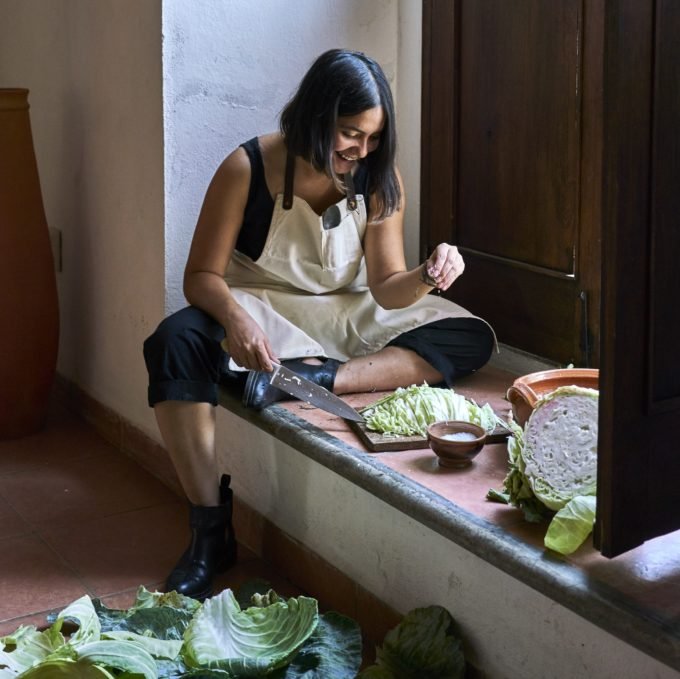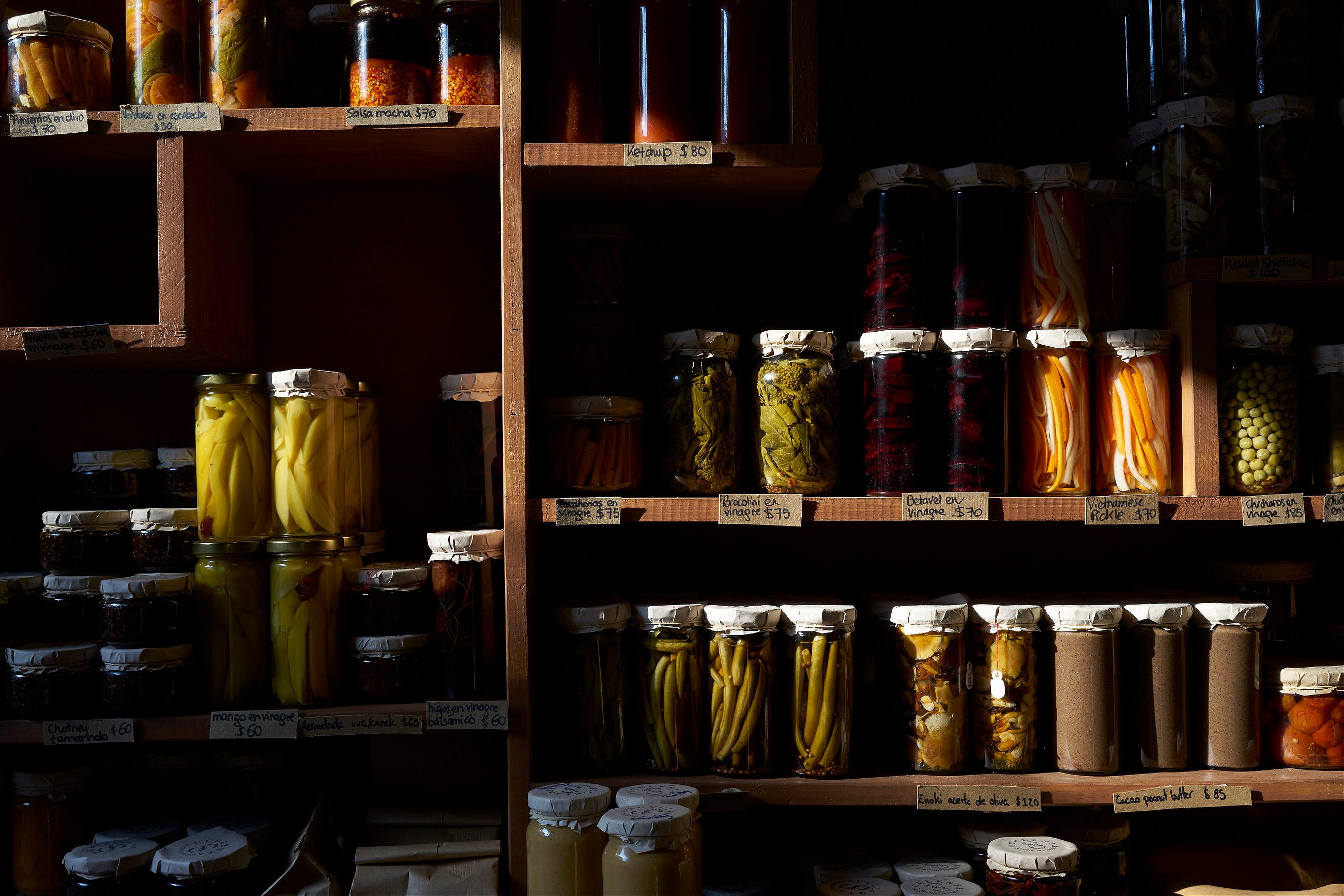
Fermenting in Oaxaca

Paulina Garcia talks with Nathan about mushroom tea, coyote skins, and how her group of Norteños ended up living in Oaxaca.
This week on The Trip: Drinking with Exceptional People Around the World, host Nathan Thornburgh heads to Oaxaca to talk fermentation. Nathan chats with Paulina Garcia, a partner in the bakery, Boulenc, and owner of the fermentation and canning shop, Suculenta, about how she and her group of friends ended up starting two businesses that produce beautiful food, Paulina’s obsession with beautiful jars, and coyote skins.
Here is a condensed transcript of the conversation. You can listen to the full episode, for free, on Apple Podcasts, Stitcher, Spotify, or wherever you get your podcasts.
Nathan Thornburgh: You said that before you moved to Oaxaca that you had never thought about living here. Why?
Paulina Garcia: Because I was still studying graphic design and my plan was not to be a graphic designer in Oaxaca. I didn’t exactly know what my plan was, but it wasn’t going to happen in Oaxaca. And I never thought I was going to have my own business. I never thought of myself like that. I always thought that I was going to work on this big company and be great at that.
Thornburgh: You really fucked that up.
Garcia: Yeah. But it’s turned out OK.
Thornburgh: Sometimes it’s good to fuck up a plan, you know?
Garcia: Or several.
Thornburgh: Oaxaca’s the kind of place, where people visit and then think, “Oh shit I’m not going back home.”
Garcia: That happens a lot.
Thornburgh: It has this manageable vibe. It’s easy to see yourself in this setting.
Garcia: It’s a very attractive city. It’s so abundant in so many resources that people from different disciplines can find opportunities here.
Thornburgh: So, all of your partners in the Boulenc and Suculenta businesses are from the Saltillo.
Garcia: Yes. I have three business partners. They’re all guys and they’re all from Saltillo.
Thornburgh: And the four of you moved to Oaxaca separately?
Garcia: Yeah, separately. It was really, really, I don’t even know how I got here. It was, I don’t know how it happened, it was really weird. Juan Pablo was the first person to move here. He originally moved here to work in the restaurant of another friend of ours. Once he started working in the restaurant, he started learning to how to bake different types of bread that weren’t traditional Mexican bread.
He was baking a lot of bread, like sourdough, that he needed to sell. So he started selling it outside this organic market. All the Europeans and Americans that lived in Oaxaca recognized the bread immediately and they started to buy it.
Thornburgh: They were probably fucking dying for that.
Garcia: Yeah. The restaurant where Juan Pablo worked ended up going broke, but he stayed in Oaxaca. Soon, another friend of ours, Bernardo, contacted Juan Pablo. Bernardo was living in New Zealand, illegally, at the time. He gave Juan Pablo $3,000 he had saved so he could open a bakery. Bernando just wanted to be a partner in the business. Juan Pablo agreed, got the space for what is now Boulenc, and then ordered the oven.
Three days after Juan Pablo ordered the oven, Bernardo got deported.
Thornburgh: Oh, shit.
Garcia: Yeah, he got deported and then went to Saltillo. He didn’t like Saltillo and decided to move to Oaxaca and close to the bakery, which he had invested in.
Thornburgh: He’s a Oaxacan baker now.
Garcia: This is where things get interesting. My boyfriend at the time, who is one of my current business partners, was working at this farm in Queretaro while I was still living in Saltillo. He quit this job and said he was moving back to Saltillo I was like, “Perfect. I’ll see you here. I haven’t seen you in months. I’ll see you in Saltillo.” Then he calls me and he says, “You know what, my friends Juan Pablo and Bernardo just opened up a bakery one week ago in Oaxaca. I think I’m going to go down there to check it out and just be there for a couple of weeks and then I’ll come back.” I was like Okay. He never came back.
Thornburgh: That was it?

Garcia: That was it. He moved to Oaxaca, and he was living in the bakery with the other guys because they didn’t have money to rent an apartment. All they had was an oven, two buckets where they would sit, and yoga mats.
I had already planned a trip to Oaxaca with one of my best friends before all this. It was an instant success. It’s bread, but it’s good bread. Oaxaca was missing that.
Thornburgh: You can find artisanal bread that’s well done, but I think most mainstream Mexican bread is pretty underwhelming.
Garcia: It’s also pretty cheap. You can buy sweet bread for like two pesos or three pesos.
Thornburgh: That’s about seventeen or eighteen pesos to a dollar. Some kind of bread that cost two pesos is like a ten-cent bread.
Garcia: Everybody can buy bread because it’s so cheap. It was a little bit hard to get Mexicans to accept the bread Boulenc was selling because they thought it was too expensive. But it’s made with organic butter from this nearby town and uses high-quality chocolate and other ingredients.
We got a lot of support from foreigners and the tourists that visit Oaxaca. Once the locals saw that, they started to try Boulenc’s bread.
Thornburgh: So that’s how Boulenc got its start. What is the origin story of Suculenta?
Garcia: I was already living in Oaxaca, when Caro, a really good friend of mine, came to the city for six months. She and I had a lot of free time and no money, so we were trying to figure out a business that would make us money. We looked at the bakery and realized it didn’t sell anything besides bread. So we were like, “Jam! They need jam. Okay, how do we do jam?”
We started looking at recipes and experimenting. That’s how it started, but the brand wasn’t called Suculenta at the time.
Thornburgh: What was the name?
Garcia: It was horrible, I don’t want to say.
Thornburgh: Oh, come on.
Garcia: It was the Jar Bar.
Thornburgh: Jar Bar?

Garcia: I know! it was horrible! After a while, my friend decided to move back to Saltillo. I decided to stop making jam. It was really cool to experiment, but it wasn’t fun. However, Daniel, my boyfriend, convinced me to keep going because the jam went well with the bread from Boulenc. I agreed to keep going as long as he would help me. He agreed, and I renamed the brand Suculenta.
Of course, I got bored of jam, so I started looking for something else to do. How do you do pickles? I started looking for recipes and experimenting. I found out that preserving and pickling is really easy.
Thornburgh: Really?
Garcia: Yeah, I thought it was something really complex. It’s not, and you can preserve pretty much anything. I got obsessed with what a jar of preserves looks like. For example, pickled carrots. I like to put fresh thyme on the bottom, and then garlic, and then the carrots, and then seeds. It’s satisfying to finish a batch, put labels on the jars, and then place them on the shelves. It’s pretty.
Thornburgh: So how is Suculenta is doing now?
Garcia: It’s doing well. We started to make relationships with producers of different fruits and vegetables, so we’re able to make interesting products. We sometimes get some weird stuff.
Thornburgh: What kind of weird things do you see?
Garcia: Like a coyote skin. And I was like, “No thank you, sir.” Like, “Are you sure you don’t want to buy it?” And I was like, ” No thank you.”
Thornburgh: No coyote skin. Well, thank you for speaking to me about the cool things you’re doing at Boulenc and Suculenta.
Garcia: Thank you.
This conversation was edited and condensed. Listen/subscribe to the podcast on Apple Podcasts, Spotify, or Stitcher.